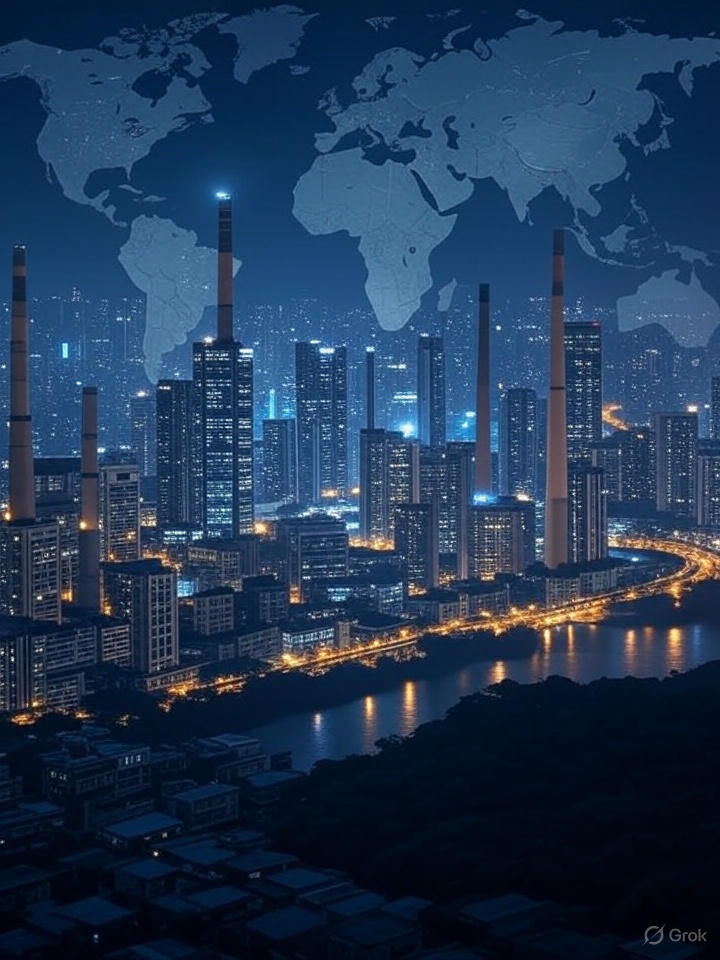A Global Economic Thriller
- thebrink2028
- Jul 22
- 4 min read

Can’t stop thinking about Tom, a factory worker I met in Ohio last month, whose overtime vanished, Aisha counting her thinning stack of naira as food prices eat her profits. Their eyes heavy with worry about tariffs shutting their plant and businesses. Then there’s Ana in São Paulo, a coder whose startup dreams are fading as investors ghost her. And Raj, a farmer in Bhopal, squinting at the sky, praying the monsoon saves his crops, because seeds and fertiliser prices have shot up. These are the pulse of our world in 2025, a world where the economy feels like it’s holding its breath.
This is about the lives behind the numbers, the warnings we’re missing, and the steps we can take to navigate what’s coming. From Lagos to Ohio to Delhi.
The Big Picture
Spending Squeeze: People everywhere are tightening their belts as wages stagnate and costs climb.
Investment Drought: Businesses and governments are holding back, spooked by uncertainty, choking off jobs and growth.
Job and Wage Struggles: New jobs are scarce, and paychecks aren’t keeping up with prices, hitting workers hard.
Trade Troubles: Tariffs and geopolitical spats are strangling exports, especially for countries leaning on trade.
Price Spikes and Weather Woes: Food and energy costs are jumping, tied to unpredictable weather and supply shocks.
Gloomy Vibes: From consumers to CEOs, pessimism is spreading, making everyone hesitate.
The Global Heartbeat: Where It Hurts
India’s economy, growing at 6.5% in 2025, looks strong but feels fragile. Wages for workers like Raj haven’t budged in real terms since 2020. Urban folks are gloomy, with the Reserve Bank’s confidence index stuck in the dumps, even if rural areas got a lift from a decent monsoon.
In Nigeria, inflation’s at a crippling 34.2%, and Aisha’s vegetable stall is proof, food prices have doubled, gutting household budgets. Brazil’s consumers, like Ana, are barely hanging on, with confidence at 74.6 as inflation chews through salaries. China’s shoppers are pulling back, with retail sales growth at a weak 3.2% in Q2 2025, thanks to a property market mess. In the U.S., Tom’s fears are mirrored in a consumer confidence drop to 68.2, with job loss worries and tariff talk biting. Germany’s feeling it too, with energy costs pushing consumer sentiment to historic lows.
“When people’s pockets are empty, the whole world feels the pinch. It’s not just numbers—it’s lives.” – CD (Inspired by a German Factory worker I spoke with)
Digging Deeper
The Rich Get Richer: In India, companies are raking in profits faster than the economy grows, but workers’ paychecks are stuck. It’s the same globally, labor’s share of income has dropped in 26 of 36 OECD countries since 2000, funneling wealth to the top and starving household spending.
Automation’s Quiet Sting: India’s IT firms cut labor cost growth from 14% in 2023 to 4% in 2024, leaning on AI. In the U.S., automation’s wiped out 1.2 million manufacturing jobs since 2010. China’s factories lost 15% of semi-skilled jobs to robots since 2015. Is this tech progress? it’s killing jobs for folks like Tom.
Trade War Tensions: U.S. tariffs, set to hit 10% on Indian goods and 25% on Chinese exports by late 2025, are a gut punch.(this could escalate further if Russian Oil picture comes in) Japan’s auto exports are getting slammed too, with margins shrinking. The WTO says global trade could slow to 2.7% in 2026 if this keeps up, (they are usually conservative in reporting their numbers).
Weather Whiplash: Nigeria’s floods cut rice yields by 20%, spiking prices. Brazil’s drought slashed soybean output by 15%, hitting global markets. Europe’s energy costs jumped 8%, tied to supply chain chaos from conflicts.
Debt Caution: India’s government trimmed debt from 88% of GDP in 2020 to 82% by 2024. Europe’s firms cut debt from 78% to 70%. It’s smart, but it means less investment, fewer jobs, and slower growth.
The IMF’s 2025 Outlook pegs global growth at 3.2%, down from 3.5% pre-COVID, with countries like Nigeria, Brazil, and India facing “serious risks” from trade and climate shocks.
Red Flags: What’s Coming
This isn’t just a rough patch, it’s a warning of worse to come:
Spending Crash: If wages don’t grow, consumer spending could collapse, risking recessions. The U.S. could see GDP drop in 2026 if confidence stays low.
Investment Stall: Global private investment dipped, as firms wait out trade uncertainty.
Trade Fallout: Tariffs could cut India’s and China's GDP by 2027.
Food Crisis: Global food inflation could hit higher in 2026, crushing low-income families like Aisha’s.
Unrest Risk: Rising costs and inequality could spark protests, like Nigeria’s 2024 riots or Brazil’s 2023 strikes.
“We’re walking a tightrope, trade, weather, tech could push us off, or we could find balance and thrive.” – CD (Paraphrased from a São Paulo economist I met).
How to Navigate This
This isn’t just for reading, it’s for doing. Here’s how you or your business can fight back:
For You: Learn skills machines can’t touch, like nursing or solar tech. Stash cash in assets or in gold to beat inflation. Side hustles can keep you afloat, its highly competitive but you must, it will help.
For Businesses: Look to growing markets like Africa or ASEAN to dodge tariffs. Bet on green tech or healthcare for steady demand. Track consumer confidence for clues on spending, follow TheBrink for regular updates.
What’s the biggest risk to the global economy in 2026?
Trade wars
Climate shocks
Automation
Debt caution
Drop your answer.
Reward: The first 100 who nail it (based on our expert take) get a free e-book, Surviving the Storm: Your 2026 Guide, loaded with tips and data.
TheBrinks - Leaked from the Future: What’s Next?
Want to know what’s coming?
Join our premium.
-Chetan Desai for TheBrink2028


